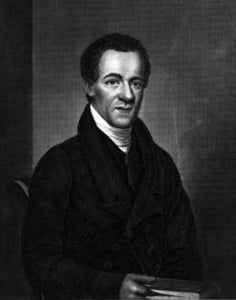Resolute in the Face of Obstacle and Opposition.
 The nation’s first Presbyterian church, organized specifically for African Americans, was located in Philadelphia and it was organized in 1807. But it was on this day, January 13th, in 1822, that what was sometimes labled the First Colored Presbyterian Church of New York City, or officially the New Demeter Street Presbyterian Church, was organized, with an initial congregation of twenty four members. The Rev. Samuel E. Cornish served as the organizing pastor, though despite his earnest efforts, the congregation’s early years were fraught with setbacks. First they lost their building, that had been built at a cost of $14,000, and then they lost their pastor in 1828, due to his declining health.
The nation’s first Presbyterian church, organized specifically for African Americans, was located in Philadelphia and it was organized in 1807. But it was on this day, January 13th, in 1822, that what was sometimes labled the First Colored Presbyterian Church of New York City, or officially the New Demeter Street Presbyterian Church, was organized, with an initial congregation of twenty four members. The Rev. Samuel E. Cornish served as the organizing pastor, though despite his earnest efforts, the congregation’s early years were fraught with setbacks. First they lost their building, that had been built at a cost of $14,000, and then they lost their pastor in 1828, due to his declining health.
Samuel Eli Cornish [1795-1858], (pictured above), labored as a Presbyterian pastor, was an ardent opponent of slavery, and in 1827 became one of the two editors of Freedom’s Journal, the nation’s first newspaper owned and operated by African Americans. He also served as a founding member of the American Anti-Slavery Society (established in 1833), and held important positions within the American Bible Society and the American Missionary Association.
 The next man called by the congregation in 1829 was the Rev. Theodore S. Wright (pictured at right), trained in part at Princeton Seminary and licensed to preach by the Presbytery of Albany. Under his leadership the congregation was able to obtain the former German Lutheran church at Frankfort and William Streets and from that time forward, until Rev. Wright’s death in 1847, the congregation prospered.
The next man called by the congregation in 1829 was the Rev. Theodore S. Wright (pictured at right), trained in part at Princeton Seminary and licensed to preach by the Presbytery of Albany. Under his leadership the congregation was able to obtain the former German Lutheran church at Frankfort and William Streets and from that time forward, until Rev. Wright’s death in 1847, the congregation prospered.
Together with Samuel Cornish, Rev. Wright was in 1833 one of the founders of the American Anti-Slavery Society, and served on its executive committee until 1840. Leaving that post, he next worked with fellow abolitionists to begin the American and Foreign Anti-Slavery Society, and also served to chair the New York Vigilance Committee which worked to prevent the kidnapping of free blacks who were then being sold into slavery. In conjunction with these efforts, he opened his home as a station on the Underground Railroad.
Of the Rev. Wright, one of his closest friends said of him,
“This devout man of God, ever in the service of his Divine Master, the Lord and Saviour Jesus Christ, of humble yet unyielding faith, full of the Holy Ghost, both as a preacher and a doer of the word, always interested, in season and out of season, in the religious state of his friends and parishioners, whose kindly voice would break in upon, no matter what discussion, with the inquiry, ‘Brother, do you enjoy religion?’ ‘Do you love Jesus Christ?’ An abolitionist of the purest water and most devoted zeal, this worthy minister cherished a warm interest in the necessity for educating to the fullest extent capable colored youth as a means of elevating his people.”
Words To Live By:
Time does not permit us here to tell at length their full stories, and I hope you will search out the matter further and read more about Rev. Cornish and Rev. Wright. There is much that we can learn from their ministries, and I don’t pretend that we have done them justice with the above brief account, other than to make you aware of them.
Do you love the Lord Jesus Christ? Is there a more important question? It is only when we are drawn to Christ and find forgiveness of our own sin that we can then offer hope and resolution to a sin-sick world. But lest those words become glib, remember that the Christian life is a sacrificial life, meant to be expended on behalf of others as we point a dying world to the only true Savior. The cost is real, but so is the Life.
Tags: African Americans Cornish, Freedom Journal, Samuel Cornish, United States

No comments
Comments feed for this article